Springfield, Illinois Blood Testing Facilities
 Represents a LabCorp blood testing facility
Represents a LabCorp blood testing facility Represents a Quest Diagnostics blood testing facility
Represents a Quest Diagnostics blood testing facility

Nearby Labcorp Blood Testing facilities:
- Labcorp Center Distance: 60 m, 1703 Clearwater Ave, Bloomington, McLean County, IL, 61704
- Labcorp Center Distance: 67 m, 2419 W. Cornerstone Ct Ste B, Peoria, Peoria County, IL, 61614
- Labcorp Center Distance: 72 m, 102 Rottingham Ste 2, Edwardsville, Madison County, IL, 62025
- Labcorp Center Distance: 75 m, 2023 Vadalebene Dr Suite 150, Maryville, Madison County, IL, 62062
- Labcorp Center Distance: 80 m, 637 Dunn Rd Ste 100A, Hazelwood, St Louis County, MO, 63042
- Labcorp Center Distance: 83 m, 12255 Depaul Dr Ste 190, Bridgeton, St Louis County, MO, 63044
- Labcorp Center Distance: 84 m, 711 Veterans Memorial Parkway, Saint Charles, St Charles County, MO, 63303
- Labcorp Center Distance: 85 m, 205 First Executive Avenue, Saint Peters, St Charles County, MO, 63376
- Labcorp Center Distance: 86 m, 3960 Lindell Blvd, Saint Louis, Other, MO, 63108
- Labcorp Center Distance: 87 m, 6994 Mexico Rd, Saint Peters, St Charles County, MO, 63376
- Labcorp Center Distance: 88 m, 1035 Bellevue Ave Ste 314, Richmond Heights, St Louis County, MO, 63117
- Labcorp Center Distance: 89 m, 1475 Kisker Rd Ste 140, Saint Charles, St Charles County, MO, 63304
- Labcorp Center Distance: 90 m, 6555 Chippewa St Ste 100, Saint Louis, Other, MO, 63109
- Labcorp Center Distance: 91 m, 1002 Peruque Crossing Ct 100, O'fallon, St Charles County, MO, 63366
- Labcorp Center Distance: 92 m, 206 East Third St, Centralia, Marion County, IL, 62801
- Labcorp Center Distance: 94 m, 816 S Kirkwood Rd Ste 110, Saint Louis, St Louis County, MO, 63122
- Labcorp Center Distance: 95 m, 28 Ronnies Plz, Saint Louis, St Louis County, MO, 63126
- Labcorp Center Distance: 97 m, 12345 W Bend Dr, Saint Louis, St Louis County, MO, 63128
Nearby Quest Blood Testing facilities:
- Quest Center Distance: 4 m, 3119 Robbins Rd, Springfield, Sangamon County, IL, 62704-6553
- Quest Center Distance: 36 m, 2905 N Main St, Decatur, Macon County, IL, 62526-4275
- Quest Center Distance: 55 m, 704 S Hackman St, Staunton, Macoupin County, IL, 62088-1630
- Quest Center Distance: 60 m, 503 N Prospect Rd, Bloomington, McLean County, IL, 61704-7723
- Quest Center Distance: 66 m, 237B E Center Dr, Alton, Madison County, IL, 62002-5931
- Quest Center Distance: 75 m, 2136 Vadalabene Dr, Maryville, Madison County, IL, 62062-5632
- Quest Center Distance: 76 m, 2107 S Neil St, Champaign, Champaign County, IL, 61820-2061
- Quest Center Distance: 79 m, 8186 N Lindbergh Blvd, Florissant, St Louis County, MO, 63031-7135
- Quest Center Distance: 83 m, 3440 Depaul Ln, Bridgeton, St Louis County, MO, 63044-2531
- Quest Center Distance: 85 m, 4101 Mexico Rd, Saint Peters, St Charles County, MO, 63376-6414
- Quest Center Distance: 86 m, 40 N Kingshighway, Saint Louis, Other, MO, 63108-1324
- Quest Center Distance: 89 m, 3030 Frank Scott Pkwy W, Belleville, St Clair County, IL, 62223-5014
- Quest Center Distance: 93 m, 17300 N Outer 40, Chesterfield, St Louis County, MO, 63005-1361
- Quest Center Distance: 97 m, 9950 Kennerly Rd, Saint Louis, St Louis County, MO, 63128-2704
Hormone Replacement Therapy Services for the State of Illinois
Are you over the age of thirty and feel that symptoms related to premature aging are bringing you down? You may actually be suffering from a condition known as hormone imbalance. Two of the most common forms of Hormone Imbalance which are associated with the aging process are Testosterone Deficiency and Human Growth Hormone Deficiency.
The Conscious Evolution Institute provides Pharmaceutical Hormone Replacement Therapy Solutions for men and women all across the United States.
HGH Deficiency Treatments in Chicago and Greater Illinois
Do you find yourself dragging as you grow older? Are you experiencing weight gain and loss of muscle mass even though you haven't changed your lifestyle? Are you experiencing psychological issues, not associated with your life circumstances, such as depression or a loss of well-being?
You may be suffering from Human Growth Hormone Deficiency, also known as Somatopause. Human beings are sensitive to hormonal changes, and as we get older, our brains secrete less and less of this vital hormone. With regular Bio-Identical HGH Shots, it is possible to negate the effects of Somatopause, potentially improving your physiological health, improving your outlook as well as reducing your mortality risk.
Sermorelin Acetate HGH Deficiency Treatment
HGH Injections aren't the only way to restore Growth Hormone Levels, however. The Conscious Evolution Institute also offers Recombinant Sermorelin Therapy, which boosts natural HGH Production by safely stimulating the pituitary gland. We can help you decide which form of treatment is best for you.
Low-T Treatments in Chicago and Greater Illinois
Testosterone Deficiency is also a major medical disorder which has the capacity to significantly disrupt the lives of both men and women. Like HGH, Testosterone production starts to fade around the time that we reach our mid-twenties. Many men don't experience issues for years or decades, but other men are much more sensitive to these hormonal changes.
Low-T is also referred to as Andropause, because it has a tendency to become symptomatic around the same period as Menopause, and can have the same powerful impact on health and wellness. If you are experiencing severe fatigue, loss of muscle mass, anxiety, or weight gain in combination with a lack of libido or loss of sexual ability, there is a major chance that you are suffering from Low-T and can benefit from the various Bio-Identical Low-T solutions that we provide.
HCG Weight Management Treatments in Chicago and Greater Illinois
Not all hormone treatments are intended specifically to correct hormone imbalance. HCG Injections are a form of Bio-Identical Hormone Replacement Therapy which has been proven as an effective medical treatment for obesity.
For men and women that have spent years struggling with their weight, HCG has the ability to break the cycle of dieting and binging which causes so many diets to fail. HCG, when combined with low calorie diet, leads to rapid weight loss, while significantly reducing the feelings of hunger and loss of energy associated with such a diet. HCG helps break free energy trapped in your adipose fat tissue, helping you maintain a healthy metabolism even with a significant reduction in caloric consumption.
Largest Cities in Illinois
Chicago
Chicago, is the largest city in Illinois, and is one of the largest cities in the United States. The only cities in America larger than Chicago are Los Angeles and New York City. Chicago is frequently referred to by its nickname: The Windy City. It's location adjacent to Lake Michigan causes it to experience high levels of snow and wind.
Chicago is also referred to as the Second City, because of its significant size and cultural importance, historically only considered second to New York City. Because Chicago is such a large city, it has a number of sports teams. Chicago is home to the MLB teams the Chicago Cubs and White Sox. It is also home to the NFL Chicago Bears and the NBA Chicago Bulls.
Aurora
Aurora is the second largest city in Illinois, as well as the largest suburb of Chicago. Historically, Aurora was known as The City of Lights, because it was among the first places in America to have street lights controlled completely by electricity.
A unique thing about Aurora is that it has a high concentration of buildings with renowned architecture, with buildings designed by architectural mavens such as Bruce Goff and Frank Lloyd Wright. Like many cities in the Midwest, Aurora has long been known for its significant contribution to national manufacturing.
Rockford
Rockford, Illinois is the third largest city in the state of Illinois, and the largest city outside of the Metro Chicago area. Rockford is often mentioned by the nickname, The Forest City, because of the many large elm trees located throughout the city. It was also one of the first cities in the United States with organized baseball, hosting a team called the Rockford Forest City.
Rockford has experienced issues in recent years because of the decline of the manufacturing sector in the Midwest, but has entered a new era of revitalization in recent years. Today, the largest private sector business in the city is Belvedere Assembly Plant for Chrysler and the largest Public Sector employer is the Rockford school system.
Joliet
Joliet, Illinois is the fourth largest city in Illinois, and is the second largest suburb of Chicago. Joliet is located southwest of Chicago, and is growing faster than any other city in the state. Joliet is often referred to as The City of Champions because of the massive success of the bands of the Joliet Township public school system.
Joliet, like many other cities in the Rust Belt, experienced a significant loss of jobs as manufacturing declined in the area, but its proximity to Chicago has caused it to bounce back in a big way as a suburb for men and women that commute to Chicago. Joliet also has an active entertainment district in its city center, with the minor league team the Joliet Slammers and Harrah's Joliet Casino.
Naperville
Naperville, Illinois is the 5th largest city in the state of Illinois, as well as the third largest suburb of Chicago. Naperville also has the unique distinction of being considered the richest city in the Midwest as well as one of the best cities to live in and raise a family in America.
Naperville belongs to an area known as the Illinois Tech and Research Corridor, and has a large number of high tech jobs, the most significant of which being Alcatel-Lucent and Nicor. Although high tech is the largest industry in the city, the largest single employer is Edward Hospital.
All About Springfield, Illinois Geographic Area
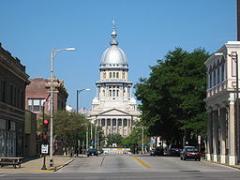

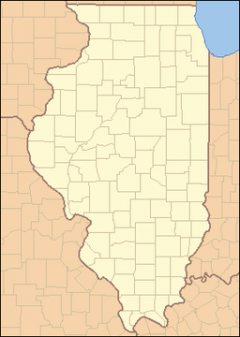
Springfield is the third and current capital of the US state of Illinois and the county seat of Sangamon County with a population of 116,250 (U.S. Bureau of the Census, 2010), making it the sixth most populated city in the state and the second most populated Illinois city outside of the Chicago Metropolitan Area. It is the largest city in central Illinois. Just over 208,000 residents live in the Springfield Metropolitan Statistical Area, which includes Sangamon County and adjacent Menard County. Present-day Springfield was first settled by European Americans in the late 1810s, around the time Illinois became a state. The most famous past resident is Abraham Lincoln, who lived in Springfield from 1837 until 1861, when he went to the White House as President. Major tourist attractions include a multitude of historic sites connected with Lincoln. In 1908 a large race riot erupted in the city, which resulted in the lynching of two African-American men and deaths of four whites killed by defenders of black areas; it led to the founding of the National Association for the Advancement of Colored People (NAACP).
The city lies on a mostly flat plain which encompasses much of the surrounding countryside. Hilly terrain lies near the Sangamon River. Lake Springfield, a large artificial lake owned by City Water, Light & Power company called CWLP, supplies the city with recreation and drinking water. Weather is fairly typical for middle latitude locations, with hot summers and cold winters. Spring and summer weather is like that of most midwestern cities; severe thunderstorms are common. Tornadoes hit Springfield in 1957 and 2006.
The city is governed by a mayor-council form of government. The city proper is also the "Capital Township" governmental entity. In addition, the government of the state of Illinois is also based in Springfield. State government entities located in the city include the Illinois General Assembly, the Illinois Supreme Court and the Office of the Governor of Illinois. There are three public and two private high schools in Springfield. Public schools in Springfield are operated by District No. 186. The economy of Springfield is marked by government jobs, which account for a large percentage of the work force in the city.
Springfield's original name was Calhoun, after Senator John C. Calhoun of South Carolina. The land that Springfield now occupies was originally settled by trappers and traders who came to the Sangamon River in 1818. The settlement's first cabin was built in 1820, by John Kelly, its site is at the northwest corner of Second Street and Jefferson Street. In 1821, Calhoun became the county seat of Sangamon County; due to the fertile soil, and trading opportunities. Settlers from Kentucky, Virginia, and as far as North Carolina came to the city. By 1832, Senator Calhoun had fallen out of the favor with the public and the town renamed itself Springfield after Springfield, Massachusetts. At that time, Springfield, Massachusetts was comparable to modern-day Silicon Valley -- known for industrial innovation, concentrated prosperity, and the celebrated Springfield Armory. Most importantly, it was a city that had built itself up from frontier outpost to national power through ingenuity - an example that the newly named Springfield, Illinois, sought to emulate. Kaskaskia was the first capital of the Illinois Territory from its organization in 1809, continuing through statehood in 1818, and through the first year as a state in 1819. Vandalia was the second state capital of Illinois from 1819 to 1839. Springfield became the third and current capital of Illinois in 1839. The designation was largely due to the efforts of Abraham Lincoln and his associates; nicknamed the "Long Nine" for their combined height of 54 feet (16 m).
Lincoln arrived in the Springfield area when he was a young man in 1831, though he would not actually live in the city until 1837. He spent the ensuing six years in New Salem where he began his legal studies, joined the state militia and was elected to the Illinois General Assembly. In 1837 Lincoln moved to Springfield and spent the next 24 years as a lawyer and politician. Lincoln delivered his Lyceum address in Springfield. His farewell speech when he left for Washington is a classic in American oratory.
Winkle (1998) examines the historiography concerning the development of the Second Party System (Whigs versus Democrats) and applies these ideas to the study of Springfield, a strong Whig enclave in a Democratic region, mainly by studying poll books for presidential years. The rise of the Whig Party took place in 1836 in opposition to the presidential candidacy of Martin Van Buren and was consolidated in 1840. Springfield Whigs tend to validate several expectations of party characteristics as they were largely native-born, either in New England or Kentucky, professional or agricultural in occupation, and devoted to partisan organization. Abraham Lincoln's career mirrors the Whigs' political rise, but by the 1840s Springfield began to fall into Democrat hands, as immigrants changed the city's political makeup. By the 1860 presidential election, Lincoln was barely able to win his home city.
Winkle (1992) examines the impact of migration on political participation in Springfield during the 1850s. Widespread migration in the 19th-century United States produced frequent population turnover within Midwestern communities, which influenced patterns of voter turnout and office-holding. Examination of the manuscript census, poll books, and office-holding records reveals the impact of migration on the behavior of 8,000 participants in 10 elections in Springfield. Most voters were short-term residents who participated in only one or two elections during the 1850s, and fewer than 1% of all voters participated in all 10 elections. Instead of producing political instability, however, rapid turnover enhanced the influence of more persistent residents. Migration was selective by age, occupation, wealth, and birthplace. Therefore, more persistent voters were wealthier, more highly skilled, more often native-born, and socially more stable than nonpersisters. Officeholders were particularly persistent and socially and economically advantaged. Persisters represented a small "core community" of economically successful, socially homogeneous, and politically active voters and officeholders who controlled local political affairs while most residents moved in and out of the city. Members of a tightly knit and exclusive "core community," exemplified by Abraham Lincoln, blunted the potentially disruptive impact of migration on local communities.
The business career of John Williams illustrates the important role of the merchant banker in the economic development of central Illinois before the Civil War. Williams began his career as a clerk in frontier stores and saved to begin his own business. Later, in addition to operating retail and wholesale stores, he acted as a local banker and then organized a national bank in Springfield. He was active in railroad promotion and as an agent for farm machinery.
During the mid-19th century the spiritual needs of German Lutherans in the Midwest were not being tended. As a result of the efforts of such missionaries as Friedrich Wyneken, Wilhelm Loehe, and Wilhelm Sihler, this situation was remedied by the deployment of additional Lutheran ministers, the opening of Lutheran schools, and the creation in Ft. Wayne of the Concordia Seminary in 1846. The Seminary moved to St. Louis, Missouri, in 1869, and its practical division moved to Springfield in 1874. Through this seminary, during the last half of the 19th century and the first half of the 20th, the Lutheran Church Missouri Synod succeeded in serving the spiritual needs of Midwestern congregations by establishing additional seminaries, and by developing a viable synodical tradition.
The American Civil War made Springfield a major center of activity. Illinois regiments trained there, the first ones under Ulysses S. Grant, who marched his soldiers to a remarkable series of victories in 1861 ae62. The city was a political and financial center of support, and new industries, businesses, and railroads were constructed to help support the war effort. The war's first official death was a Springfield resident, Colonel Elmer E. Ellsworth.
Camp Butler, seven miles (11 km) northeast of Springfield, Illinois, opened in August 1861 as a training camp for Illinois soldiers, but also served as a camp for Confederate prisoners of war through 1865. In the beginning, Springfield residents visited the camp to experience the excitement of a military venture, but many reacted sympathetically to mortally wounded and ill prisoners. While the city's businesses prospered from camp traffic, drunken behavior and rowdiness on the part of the soldiers stationed there strained relations as neither civil nor military authorities proved able to control disorderly outbreaks.
After the war ended in 1865, Springfield became a major hub in the Illinois railroad system and besides politics and farming, coal mining was a major industry for Springfield by 1900.
Local poet Vachel Lindsay's notions of utopia were expressed in his only novel, The Golden Book of Springfield (1920), which draws on ideas of anarchistic socialism in projecting the progress of Lindsay's hometown toward utopia.
The Dana-Thomas House is a Frank Lloyd Wright design built in 1902 ae03. Wright began work on the house in 1902. Commissioned by Susan Lawrence Dana, a local patron of the arts and public benefactor, Wright designed a house to harmonize with the owner's devotion to the performance of music. Coordinating art glass designs for 250 windows, doors, and panels as well as over 200 light fixtures, Wright enlisted Oak Park artisans. The house is a radical departure from Victorian architectural traditions. Covering 12,000 square feet (1,100 m2), the house contained vaulted ceilings and 16 major spaces. As the nation was changing, so Wright intended this structure to reflect the changes. Creating an organic and natural atmosphere, Wright saw himself as an "architect of democracy" and intended his work to be a monument to America's social landscape.
It is the only historic site later acquired by the state exclusively because of its architectural merit. The structure was opened to the public as a museum house in September 1990; tours are available, 9:00 am ae4 pm Wednesdays through Sundays.
Sparked by the alleged rape of a white woman by a black man and the murder of a white engineer, supposedly also by a black man, in Springfield, and reportedly angered by the high degree of corruption in the city, some white residents took their anxiety and frustration out on blacks. Rioting broke out on August 14, 1908 and continued for three days in a period of violence known as the Springfield Race Riot. Gangs of white youth and blue-collar workers attacked the predominantly black areas of the city known as the Levee district, where most black businesses were located, and the Badlands, where many black residences stood. Two blacks were lynched and four whites were killed by gunfire when black property-owners sought to defend their homes and businesses. The riot ended when the governor sent in more than 3,700 militiamen to patrol the city, but isolated incidents of white violence against blacks continued in Springfield into September.
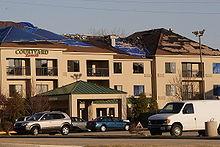
On March 12, 2006, Two EF2 tornadoes hit the city, injuring 24 people, damaged hundreds of buildings, and caused $150 million in damages.
On February 10, 2007, then-senator Barack Obama announced his presidential candidacy in Springfield, standing on the grounds of the Old State Capitol. Senator Obama also used the Old State Capitol in Springfield as a backdrop when he announced Joe Biden as his running mate on August 23, 2008.
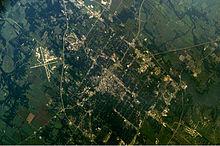
Springfield is located at 39 °47 a²00 a³N 89 °39 a²01 a³W / 39.783250 °N 89.650373 °W / 39.783250; -89.650373. The city is at an elevation of 586 feet (178.6 m) above sea level. Located within the central section of Illinois, Springfield is 90 miles northeast of St. Louis. The Champaign/Urbana area is to the east, Peoria, Illinois is to the north, and Bloomington/Normal is to the northeast.
According to the 2010 census, the city has a total area of 65.76 square miles (170.3 km2), of which 59.48 square miles (154.1 km2) (or 90.45%) is land and 6.28 square miles (16.3 km2) (or 9.55%) is water. The city is located in the Lower Illinois River Basin, in a large area known as Till Plain. Sangamon County, and the city of Springfield, are in the Springfield Plain subsection of Till Plain. The Plain is underlain by glacial till that was deposited by a large continental ice sheet that repeatedly covered the area during the Illinoian Stage.
The majority of the Lower Illinois River Basin is flat, with relief extending no more than 20 feet (6.1 m) in most areas, including the Springfield subsection of the plain. The differences in topography are based on the age of drift. The Springfield and Galesburg Plain subsections represent the oldest drift, Illinoian, while Wisconsinian drift resulted in end moraines on the Bloomington Ridged Plain subsection of Till Plain.
Lake Springfield is a 4,200-acre (1,700 ha) man-made reservoir owned by City Water, Light & Power, the largest municipally owned utility in Illinois. It was built and filled in 1935. The lake is used primarily as a source for drinking water for the city of Springfield, also providing cooling water for the condensers at the power plant on the lake. It attracts approximately 600,000 visitors annually and its 57 miles (92 km) of shoreline is home to over 700 lakeside residences and eight public parks.
The term "full pool" describes the lake at 560 feet (170.7 m) above sea level and indicates the level at which the lake begins to flow over the dam's spillway, if no gates are opened. Normal lake levels are generally somewhere below full pool, depending upon the season. During the drought from 1953 to 1955, lake levels dropped to their historical low, 547.44 feet (166.86 m) AMSL. The highest recorded lake levels were in December 1982, when the lake crested at 564 feet (172 m).
Springfield has a humid continental climate (Koppen Dfa) and experiences typical mid-latitude weather. Hot, humid summers and cold, rather snowy winters are the norm. Illinois also experiences large numbers of tornadoes. From 1961 to 1990 the city of Springfield averaged 35.25 inches (895 mm) of precipitation per year. During that same period the average yearly temperature was 52.4 °F (11.3 °C), with a summer maximum of 76.5 °F (24.7 °C) in July and a winter minimum of 24.2 °F ( na4.3 °C) in January.
From 1971 to 2000, NOAA data showed that Springfield's annual mean temperature increased slightly to 52.7 °F (11.5 °C). During that period, July averaged 76.3 °F (24.6 °C), while January averaged 25.1 °F ( na3.8 °C).
In 1957 a tornado hit Springfield, killing two people. On March 12, 2006, the city was struck by two F2 tornadoes. The storm system which brought the two tornadoes hit the city around 8:30pm; no one died as a result of the weather. Springfield received a federal grant in February 2005 to help improve its tornado warning systems and new sirens were put in place in November 2006 after eight of the sirens failed during an April 2006 test, shortly after the tornadoes hit. The cost of the new sirens totaled $983,000. Although tornadoes are not uncommon in central Illinois, the March 12 tornadoes were the first to hit the actual city since the 1957 storm. The 2006 tornados followed nearly identical paths to that of the 1957 tornado.
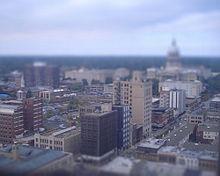
Springfield proper is greatly based on a grid street system, with numbered streets starting with the longitudinal First Street which leads to the Illinois State Capitol and leading to 32nd Street in the far eastern part of the city. Previously the city had four distinct boundary streets: North, South, East, and West Grand Avenues. Since expansion, West Grand Avenue became MacArthur Boulevard and East Grand became 19th Street on the north side and 18th Street on the south side. 18th Street has since been renamed after Martin Luther King Jr. North and South Grand Avenues (which run east aewest) have remained important corridors in the city. At South Grand and Eleventh Street, the old "South Town District" lies, with the City of Springfield undertaking a huge redevelopment project there.
Latitudinal streets range from names of presidents in the downtown area to names of notable people in Springfield and Illinois to names of institutions of higher education, especially in the Harvard Park neighborhood.
Springfield has at least twenty separately designated neighborhoods, though not all are incorporated with associations. They include: Benedictine District, Bunn Park, the Cabbage Patch, Eastside, Enos Park, Glen Aire, Harvard Park, Hawthorne Place, Historic West Side, Laketown, Lincoln Park, Medical District, Near South, Northgate, Oak Ridge, Old Aristocracy Hill, Shalom, Springfield Lakeshore, Twin Lakes, UIS Campus, Victoria Lake, Vinegar Hill, and Westchester neighborhoods.
The Lincoln Park Neighborhood is an area bordered by 3rd Street on its west, Black Avenue on the north, 8th street on the east and North Grand Avenue. The neighborhood is not far from Lincoln's Tomb on Monument Avenue.
Springfield also encompasses four different suburban villages that have their own municipal governments. They include Jerome, Leland Grove, Southern View and Grandview.
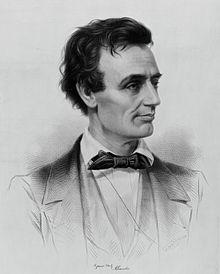
Springfield has been home to a wide array of individuals, who, in one way or another, contributed to the broader American culture. Wandering poet Vachel Lindsay, most famous for his poem "The Congo" and a booklet called "Rhymes to be Traded for Bread", was born in Springfield in 1879. At least two notable people affiliated with American business and industry have called the Illinois state capital home at one time or another. Both John L. Lewis, a labor activist, and Marjorie Merriweather Post, the founder of the General Foods Corporation, lived in the city; Post in particular was a native of Springfield. In addition, astronomer Seth Barnes Nicholson was born in Springfield in 1891.
Springfield and the Sangamon Valley enjoy a strong literary tradition in Abraham Lincoln, Vachel Lindsay, Edgar Lee Masters, John Hay, William H. Herndon, Benjamin P. Thomas, Paul Angle, Virginia Eiffert, Robert Fitzgerald and William Maxwell, among others. Heritage and legacy endure today in Illinois ao state capital, where four institutions of higher learning; a state-of-the-art, world-class library and museum; and a solid society of artistic interests contribute to the region's culture.
The Hoogland Center for the Arts in downtown Springfield is a centerpiece for performing arts, and houses among other organizations the Springfield Theatre Centre, the Springfield Ballet Company, the Illinois Symphony Orchestra and the Springfield Municipal Opera, also known as The Muni, which stages community theatre productions of Broadway musicals outdoors each summer. Before being purchased and renamed, the Hoogland Center was Springfield's Masonic Temple. Prior to the Hoogland, the Springfield Theatre Centre was housed in the nearby Legacy Theatre.
A few films have been created or had elements of them created in Springfield. Legally Blonde 2 was filmed in Springfield in 2003.
Musicians Artie Matthews and Morris Day both once called Springfield home. Other performing arts such as music and ballet are also common in Springfield.
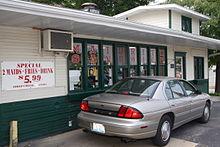
Springfield is known for some popular food items: the corn dog on a stick is claimed to have been invented in the city under the name auCozy Dog, au although there is some debate to the origin of the snack. The horseshoe sandwich, not well known outside of central Illinois, also originated in Springfield. Springfield was once the site of the Reisch Beer brewery.
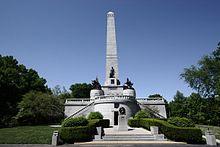
The Maid-Rite Sandwich Shop in Springfield still operates what it claims as the first U.S. drive-thru window. The city is also known for its chili, or auchilli au, as it is known in many chili shops throughout Sangamon County. The unique spelling is said to have begun with the founder of the Den Chilli Parlor in 1909, due to a spelling error in its sign. Another interpretation is that the misspelling represented the auIll au in the word Illinois. In 1993 the Illinois state legislature adopted a resolution proclaiming Springfield the auChilli Capital of the Civilized World. au
The city of Springfield is dotted with sites associated with the U.S. President, Abraham Lincoln, who started his political career there. These include the Lincoln Home National Historic Site, a National Historical Park that includes the preserved surrounding neighborhood; the Lincoln-Herndon Law Offices State Historic Site, the Lincoln Tomb State Historic Site, the Old State Capitol State Historic Site, the Lincoln Depot, from which Abraham Lincoln departed Springfield to be inaugurated in Washington D.C.; the Elijah Iles House, Edwards Place and the Abraham Lincoln Presidential Library and Museum. Near the village of Petersburg, is New Salem State Park, a restored hamlet of log cabins. This is a reconstruction of the town where Lincoln lived as a young man. With the opening of the Presidential Library and Museum in 2004, the city has attracted numerous prominent visitors, including President George W. Bush, the actor Liam Neeson, and the Emir of Qatar.
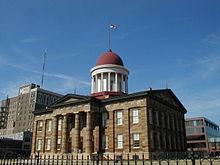
The Donner Party, a group of pioneers who resorted to cannibalism while snowbound during a winter in the Sierra Nevada Mountains, began their journey West from Springfield. Springfield's Dana-Thomas House is among the best preserved and most complete of Frank Lloyd Wright's early "Prairie" houses. It was built in 1902 ae1904 and has many of the furnishings Wright designed for it. Springfield's Washington Park is home to Thomas Rees Memorial Carillon and the site of a carillon festival, held annually since 1962. In August, the city is the site of the Illinois State Fair.
Although not born in Springfield, Lincoln is the city's most famous resident. He lived there for 24 years. The only home he ever owned is open to the public, seven days a week, free of charge, and operated by the National Park Service.
Springfield has the area's largest amusement park: Knights Action Park and Caribbean Water Park, which is Open from May to September.
Historically, Springfield has been home to a number of minor league baseball franchises, the latest club, the Springfield Sliders, arriving in the city in 2008. The city was the home of the Springfield Stallions, an indoor football team who played at the Prairie Capital Convention Center in 2007. Today, the city is host to the Springfield Junior Blues, a North American Hockey League team that plays at the Nelson Recreation Center. The city is also a host to several Semi Pro Football Teams. The oldest organization is the Capital City Outlaws which was established in 1992. The Outlaws which played 11 man football, most recently in The Midwest Football League until 2004, switched to an 8 man Semi Pro Football League (8FL) in 2004. The Sangamon County Seminoles became an expansion team in the 8FL in 2008. A newly formed team in 2010, the Springfield Foxes, plays in the Mid States Football League (11 man).
The city has produced several notable professional sports talents. Current and former Major League Baseball players, Kevin Seitzer, Jeff Fassero, Ryan O'Malley, Jason and Justin Knoedler, and Hall of Famer Robin Roberts were all born in Springfield. Former MLB player Dick "Ducky" Schofield is currently an elected official in Springfield, and his son Dick Schofield also played in the Major Leagues, as does Ducky's grandson, Jayson Werth. Ducky, Dick, and Jayson were all born in Springfield. Ducky's daughter (and Jayson's mother) Kim Schofield Werth, also from Springfield, is a track star who competed in the U.S. Olympic Trials. National Basketball Association players Dave Robisch, Kevin Gamble, and Andre Iguodala are also all from the city. Long-time NFL announcer (NBC) and former Cincinnati Bengal Pro Bowl tight end Bob Trumpy is a city native, having graduated from Springfield High School. Former NFL wide receiver, Otto Stowe, was a 1967 graduate of the now defunct Feitshans High School. A UFC fighter, Matt Mitrione, attended and played football for Sacred Heart Griffin. He also played in the NFL as an undrafted free agent for several teams.
The State Journal-Register is the primary daily newspaper for Springfield, and its surrounding area. The newspaper was originally founded in 1831 as the Sangamon Journal, and claims to be "the oldest newspaper in Illinois." The local alternative weekly is the Illinois Times. There are four TV channels which include WCIX MYTV 49, WICS ABC 20, WRSP FOX 55, and WSEC PBS 14. Springfield is also served by an NBC affiliate in Decatur (WAND-TV) and a CBS affiliate in Champaign (WCIA). One television station that has since ceased to exist was WJJY-TV, which operated in the Springfield area for three years (1969 ae1971).
Many of the jobs in the city center around state government, headquartered in Springfield. As of 2002, the State of Illinois is both the city and county's largest employer, employing 17,000 people across Sangamon County. As of February 2007, government jobs, including local, state and county, account for about 30,000 of the city's non-agricultural jobs. Trade, transportation and utilities, and the health care industries each provide between 17,000 and 18,000 jobs to the city. The largest private sector employer in 2002 was Memorial Health Systems. 3,400 people worked for that company. According to estimates from the "Living Wage Calculator", maintained by Pennsylvania State University, the living wage for the city of Springfield is $7.50 per hour for one adult, approximately $13,000 working 2,000 hours per year. For a family of four costs are increased and the living wage is $19.49 per hour within the city. According to the United States Department of Labor's Bureau of Labor Statistics (BLS) the Civilian Labor force dropped from 116,500 in September 2006 to 113,400 in February 2007. In addition, the unemployment rate rose during the same time period from 3.8% to 5.1%.
According to the City's 2010 Comprehensive Annual Financial Report, the largest employers in the city are:
At the 2010 Census, 75.8% of the population was White, 18.5% Black or African American, 0.2% American Indian and Alaska Native, 2.2% Asian, and 2.6% of two or more races. 2.0% of Springfield's population was of Hispanic or Latino origin (they may be of any race). Non-Hispanic Whites were 74.7% of the population in 2010, down from 87.6% in 1980.
As of the census of 2000, there were 111,454 people, 48,621 households, and 27,957 families residing in the city. The population density was 2,063.9 people per square mile (796.9/km ²). There were 53,733 housing units at an average density of 995.0 per square mile (384.2/km ²). The racial makeup of the city was 81.0% White, 15.3% African American, 0.2% Native American, 1.5% Asian,
There were 48,621 households, out of which 27.5% had children under the age of 18 living with them, 41.1% were married couples living together, 12.9% had a female householder with no husband present, and 42.5% were non-families. 36.1% of all households were made up of individuals and 11.7% had someone living alone who was 65 years of age or older. The average household size was 2.24 and the average family size was 2.94.
In the city the population was spread out, with 28.0% under the age of 18, 8.8% from 18 to 24, 29.8% from 25 to 44, 23.0% from 45 to 64, and 14.4% who were 65 years of age or older. The median age was 37 years. For every 100 females there were 88.6 males. For every 100 females age 18 and over, there were 86.6 males.
The median income for a household in the city was $39,388, and the median income for a family was $51,298. Families with children had a higher income of about $69,437. Males had a median income of $36,864 versus $28,867 for females. The per capita income for the city was $23,324. About 8.4% of families and 11.7% of the population were below the poverty line, including 17.3% of those under age 18 and 7.7% of those age 65 or over.
Springfield city government is structured under the mayor-council form of government. It is the strong mayor variation of that type of municipal government, the mayor holds executive authority, including veto power, in Springfield. The executive branch also consists of 17 non-elected city "offices." Ranging from the police department to the Office of Public Works, each office can be altered through city ordinance.
Elected officials in the city, mayor, aldermen, city clerk, and treasurer, serve four year terms. The elections are not staggered. The council members are elected from ten districts throughout the city while the mayor, city clerk and city treasurer are elected on an at-large basis. The council, as a body, consists of the ten aldermen and the mayor, though the mayor is generally a non-voting member who only participates in the discussion. There are a few instances where the mayor does vote on ordinances or resolutions: if there is a tie vote, if more than half of the aldermen support the motion, whether there is a tie or not, and where a vote greater than the majority is required by the municipal code.
As the state capital, Springfield, is home to the three branches of Illinois government. Much like the United States federal government, Illinois government has an executive branch, occupied by the state governor, a legislative branch, which consists of the state senate and house, and a judicial branch, which is topped by the Illinois Supreme Court. The Illinois legislative branch is collectively known as the Illinois General Assembly.
The Capital Township formed from Springfield Township on July 1, 1877, and was established and named by the Sangamon County Board on March 6, 1878, and the limits of the township and City of Springfield were made co-extensive on February 17, 1892 to better serve the people. There are three functions of this township: assessing property, collection first property tax payment, and assisting residents that live in the township. One thing that makes the Capital township unique is that the township never has to raise taxes for road work, since the roads are maintained by the Springfield Department of Public Works.
Springfield is home to at least eight public and private high schools.
The Springfield public school district is District No. 186. District 186 operates 24 elementary schools and an early learning center, (pre-K). District 186 operates three high schools, Lanphier High School, Springfield High School and Springfield Southeast High School, which replaced Feitshans High School in 1967, and five middle schools.
Springfield hosts three Universities. One is the University of Illinois at Springfield, which is located on the southeast side of the city. The second is Benedictine University at Springfield located on North Fifth Street, and the third is Robert Morris University (Illinois), located on Montvale, just off Wabash. Springfield is also home to a junior college Lincoln Land Community College.
The city is home to the Springfield campus of the Southern Illinois University School of Medicine, which includes a Cancer Institute in Springfield's Medical District.
Springfield's Sacred Heart-Griffin High School is a city Catholic high school. Other area high schools include Calvary Academy and Lutheran High School.
There are two Springfield hospitals, Memorial Medical Center and St. John's Hospital. A third hospital, named Doctor's Hospital operated on Springfield's south side until 1999.
St. John's Hospital is home to the Prairie Heart Institute, which performs more cardiovascular procedures than any other hospital in Illinois. The dominant health care provider in the area is Springfield Clinic. The major medical education concern in the area is the Southern Illinois University School of Medicine.
The Springfield Park District operates more than 30 parks throughout the city. The two best-known are Carpenter Park, an Illinois Nature Preserve on the banks of the Sangamon River, and Washington Park and Botanical Garden on the city's southwest side and adjacent to some of Springfield's most beautiful and architecturally interesting homes. Lincoln Park, located next to Oak Ridge Cemetery where President Lincoln's tomb is located, is home to the Nelson Recreation Center, which boasts a public swimming pool, tennis courts, and the city's only public ice rink, home of the Springfield Junior Blues, a minor league hockey team. Centennial Park, which rests on the outskirts of Springfield's southwest limits, holds the city's only public skatepark, as well as several ball fields, tennis courts, and a manmade hill for cardio exercises and sledding in winter months.
The owner of Lake Springfield, City Water, Light & Power, supplies electric power generated from the Dallman Power Plants for the city of Springfield and eight surrounding communities, the company also provides the cities and towns with water from the lake. In 2005, ground was broken for a third municipally owned power plant. This Power Plant has been completed and came online in 2010. Natural gas is provided via AmerenCILCO, formerly Central Illinois Light Company (CILCO).
Interstate 55 runs from north to south past Springfield, while I-72, also known as US 36, runs from east to west. Springfield is also served by Amtrak passenger trains, which operate between Chicago and St. Louis and stop at the former Gulf, Mobile & Ohio station. Local mass transportation needs are met by a bus service. The Springfield Mass Transit District (SMTD) operates Springfield's bus system. The city also lies along historic Route 66.
Border thoroughfare traffic is handled by Veterans Parkway and J. David Jones Parkway on the west side, Everett M. Dirksen Parkway on the east side, Sangamon Avenue on the north end, and Wabash Avenue, Stanford Avenue, and Adlai Stevenson Drive on the south end. The far south corridor is served by Toronto and Woodside Roads.
Abraham Lincoln Capital Airport serves the capital city with air service to Chicago/O'Hare, Dallas-Fort Worth, and Fort Myers.
Springfield and the surrounding metropolitan area has constructed bike trails and bike lanes on a number of streets. Currently four main trails exist; two significant paved trails, the Interurban Trail and the Lost Bridge Trail, serve Springfield and its suburbs of Chatham, Illinois and Rochester, Illinois respectively. A third trail, the Wabash Trail, extends westward from the northern end of the Interurban Trail toward Parkway Pointe, a regional shopping destination.
The fourth trail is a section, opened in July 2011, of the Sangamon Valley Trail spanning north to south through the west central part of Sangamon County. The section open as of 2011 extends northward from Centennial Park to Stuart Park. This trail, if completed in its entirety, will reuse the entire Sangamon County portion of the abandoned St. Louis, Peoria and North Western Railway railroad line as a trail that will extend from Virden, Illinois, to Athens, Illinois.
Springfield, Illinois, USA has four sister cities, as designated by Sister Cities International, they include the following places:
Word Count: 6622





